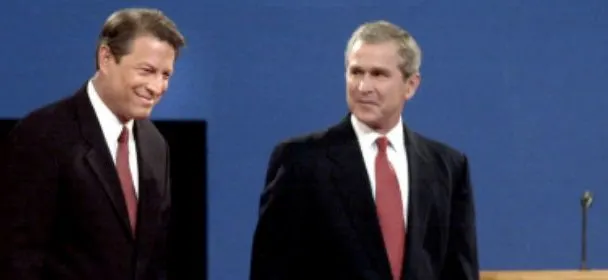| George W. Bush: | Al Gore: | Toss Up: |
2000 Election Results
Texas Gov. George W. Bush (R) defeated Vice President Al Gore (D) in the election to replace term-limited President Bill Clinton (D) on November 7, 2000.
Bush won 271 electoral votes to Gore’s 266 electoral votes. Gore won the popular vote with 48.4% of the vote to Bush’s 47.9% and Green Party candidate Ralph Nader’s 2.7%. This election is most remembered for the close race for Florida’s electoral votes, which ultimately went to Bush and split the electoral vote.
The 2000 electoral map is above. Click on the states in the map to toggle them between Democrat, Republican and Tossup.
Primaries
President Clinton was unable to run for re-election due to term limits, ensuring an open race for the office. Vice President Al Gore faced opposition from former New Jersey Senator Bill Bradley in the Democratic presidential primaries. Gore and Bradley clashed in early forums over Gore’s liberal bona fides. These clashes ultimately fell in Gore’s direction as the vice president won every primary on the way to the nomination alongside Connecticut Senator Joe Lieberman.
The main contenders in the Republican presidential primary were Bush and Arizona Senator John McCain. Bush won the Iowa caucus with activist Alan Keyes and publisher Steve Forbes not far behind running on more conservative ideas. McCain joined Bush at the front of the race by winning the New Hampshire primary.
The Bush-McCain contest continued into March before McCain withdrew from the race in the face of support for Bush from party leaders. Bush’s running mate after the 2000 Republican National Convention was former Secretary of Defense and Representative Dick Cheney.
Central Issues
Gore’s campaign contrasted his public service with Bush’s connections with wealthy donors. The vice president promoted campaign finance reforms to remove money from elections. He sought to save the federal budget surplus as a “rainy day” fund, while committing funds to improve public education and the environment. Gore also sought to separate himself from Clinton’s personal liabilities by highlighting his faith and his relationship with his wife.
Bush frequently criticized Clinton and Gore for foreign policy interventions that overextended military forces. He promoted tax cuts at all income levels and reform of federal education programs. Bush also promised a reduction in oil imports by increasing American oil production.
Strategy
The Bush and Gore campaigns spent months criticizing each other over personal style and character. Bush initially attempted to connect Gore to Clinton’s behavior in office before pivoting to the vice president’s insider credentials. The Gore campaign pointed to gaffes during speeches by Bush and questions about his intelligence in painting the governor as unqualified. Cheney and Lieberman were also deployed to carry out these strategies.

The 2000 election was the first election where the national parties outspent presidential candidates on TV advertising. The Democratic and Republican national committees spent a combined $79.9 million on TV advertising, while the Bush and Gore campaigns spent $67.1 million. Independent group spending outside of the national committees would not become a mainstay until the 2004 presidential election.
This election also solidified Democratic and Republican strongholds for future presidential races. The Bush campaign reclaimed southern states after two terms of Clinton inroads into the region. Democrats strengthened their hold on the Northeast, the Upper Midwest, and states along the Pacific coast. States with narrow margins included Florida, Pennsylvania, Ohio, and Wisconsin, which would continue as close states in future elections.
2000 Election Results Hinged on Florida
On Election Night, Bush and Gore had not reached the 270 electoral votes necessary to claim the presidency. As other close states were resolved, Florida remained the deciding factor due to its 25 electoral votes and narrow margin for Bush. Media outlets initially called the state for Gore before additional votes pushed the state back into the undecided column and later was called for Bush.
Bush’s margin of victory was certified at 537 votes on November 26, 2001, after a mandatory recount was halted by the U.S. Supreme Court. The Gore campaign challenged the results due to alleged irregularities including thousands of votes that were rejected by machines. On December 12, 2001, the U.S. Supreme Court ruled against a recount ordered by the Florida Supreme Court due to concerns over equal treatment for each vote. This ruling allowed the original certification to stand and Bush won the presidency.
The impact of Ralph Nader’s presidential campaign has been debated since the 2000 election. The Green Party candidate received 97,488 votes in Florida, far exceeding Bush’s margin of victory. The counterargument to Nader’s impact is that Green Party voters would have sat out the presidential race rather than vote for Gore.
